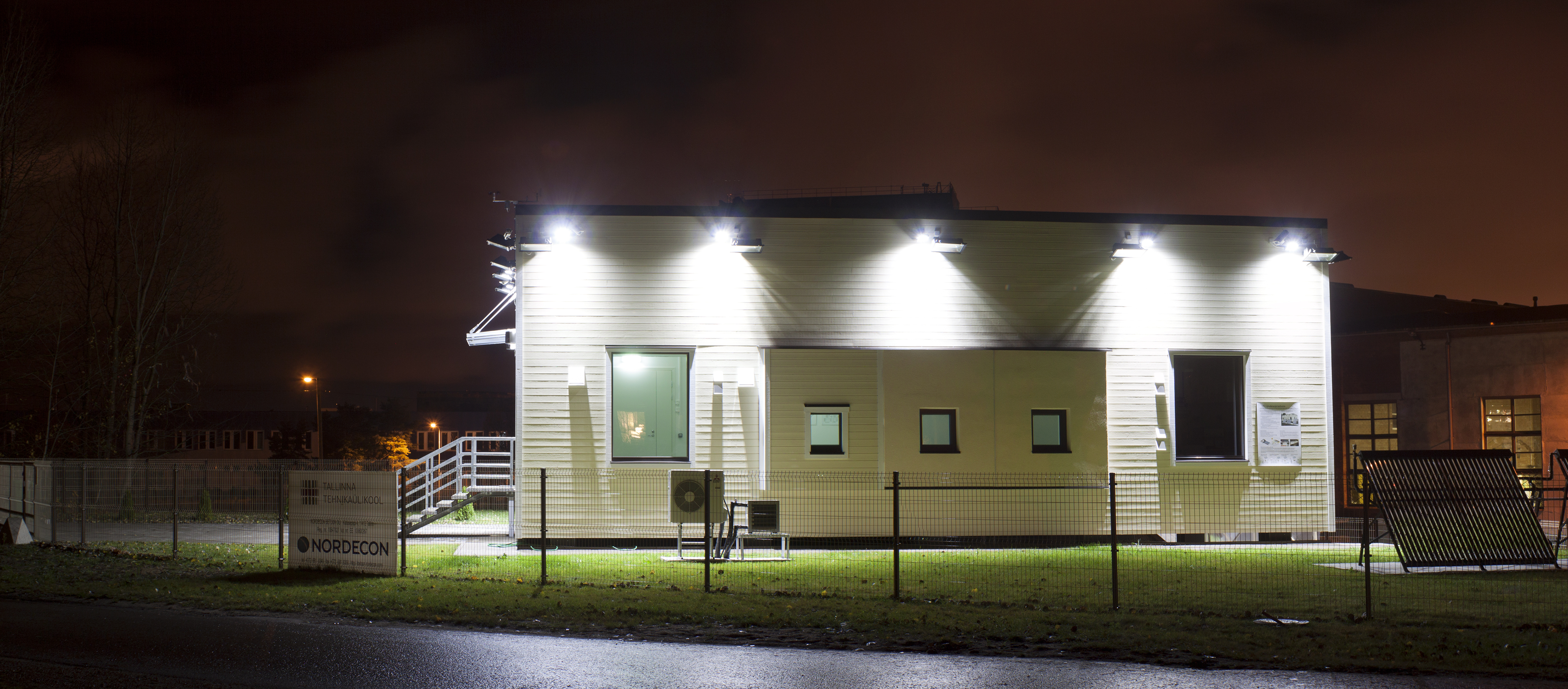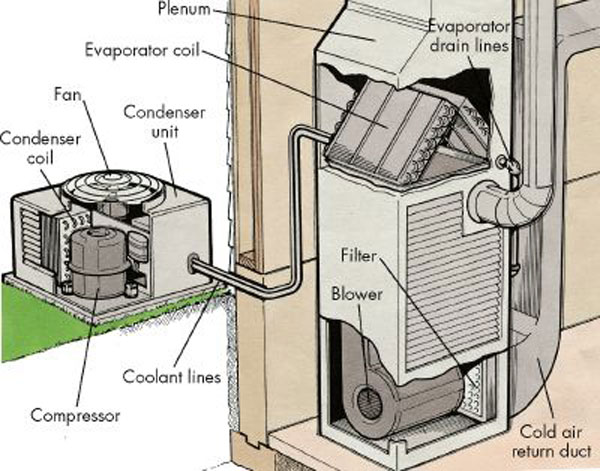|
Zero-energy Building
A Zero-Energy Building (ZEB), also known as a Net Zero-Energy (NZE) building, is a building with net zero energy consumption, meaning the total amount of energy used by the building on an annual basis is equal to the amount of renewable energy created on the site or in other definitions by renewable energy sources offsite, using technology such as heat pumps, high efficiency windows and insulation, and solar panels. The goal is that these buildings contribute less overall greenhouse gas to the atmosphere during operation than similar non-ZNE buildings. They do at times consume non-renewable energy and produce greenhouse gases, but at other times reduce energy consumption and greenhouse gas production elsewhere by the same amount. The development of zero-energy buildings is encouraged by the desire to have less of an impact on the environment, and their expansion is encouraged by tax breaks and savings on energy costs which make zero-energy buildings financially viable. Terminol ... [...More Info...] [...Related Items...] OR: [Wikipedia] [Google] [Baidu] |
HVAC
Heating, ventilation, and air conditioning (HVAC ) is the use of various technologies to control the temperature, humidity, and purity of the air in an enclosed space. Its goal is to provide thermal comfort and acceptable indoor air quality. HVAC system design is a subdiscipline of mechanical engineering, based on the principles of thermodynamics, fluid mechanics, and heat transfer. "Refrigeration" is sometimes added to the field's abbreviation as HVAC&R or HVACR, or "ventilation" is dropped, as in HACR (as in the designation of HACR-rated circuit breakers). HVAC is an important part of residential structures such as single family homes, apartment buildings, hotels, and senior living facilities; medium to large industrial and office buildings such as skyscrapers and hospitals; vehicles such as cars, trains, airplanes, ships and submarines; and in marine environments, where safe and healthy building conditions are regulated with respect to temperature and humidity, using fres ... [...More Info...] [...Related Items...] OR: [Wikipedia] [Google] [Baidu] |
Electricity Generation
Electricity generation is the process of generating electric power from sources of primary energy. For electric utility, utilities in the electric power industry, it is the stage prior to its Electricity delivery, delivery (Electric power transmission, transmission, Electric power distribution, distribution, etc.) to end users or its Grid energy storage, storage, using for example, the Pumped-storage hydroelectricity, pumped-storage method. Consumable electricity is not freely available in nature, so it must be "produced", transforming other forms of energy to electricity. Production is carried out in power stations, also called "power plants". Electricity is most often generated at a power plant by electromechanical electric generator, generators, primarily driven by heat engines fueled by combustion or nuclear fission, but also by other means such as the kinetic energy of flowing water and wind. Other energy sources include solar photovoltaics and geothermal power. There are ex ... [...More Info...] [...Related Items...] OR: [Wikipedia] [Google] [Baidu] |
Emission Intensity
Emission may refer to: Chemical products * Emission of air pollutants, notably: ** Flue gas, gas exiting to the atmosphere via a flue ** Exhaust gas, flue gas generated by fuel combustion ** Emission of greenhouse gases, which absorb and emit radiant energy within the thermal infrared range * Emission standards, limits on pollutants that can be released into the environment * Emissions trading, a market-based approach to pollution control Electromagnetic radiation * Emission spectrum, the spectrum of frequencies of electromagnetic radiation generated by molecular electrons making transitions to lower energy states * Thermal emission, electromagnetic radiation generated by the thermal motion of particles in matter * List of light sources, including both natural and artificial processes that emit light * Emission (radiocommunications), a radio signal (usually modulated) emitted from a radio transmitter * Emission coefficient, a coefficient in the power output per unit time ... [...More Info...] [...Related Items...] OR: [Wikipedia] [Google] [Baidu] |
Embedded Emissions
One way of attributing greenhouse gas emissions is to measure the embedded emissions of goods that are being consumed (also referred to as "embodied emissions", "embodied carbon emissions", or "embodied carbon"). This is different from the question of to what extent the policies of one country to reduce emissions affect emissions in other countries (the "spillover effect" and "carbon leakage" of an emissions reduction policy). The UNFCCC measures emissions according to production, rather than consumption. Consequently, embedded emissions on imported goods are attributed to the exporting, rather than the importing, country. The question of whether to measure emissions on production instead of consumption is partly an issue of equity, i.e., who is responsible for emissions. The 37 Parties listed in Annex B to the Kyoto Protocol have agreed to legally binding emission reduction commitments. Under the UNFCCC accounting of emissions, their emission reduction commitments do not include ... [...More Info...] [...Related Items...] OR: [Wikipedia] [Google] [Baidu] |
Carbon Footprint
A carbon footprint (or greenhouse gas footprint) is a calculated value or index that makes it possible to compare the total amount of greenhouse gases that an activity, product, company or country Greenhouse gas emissions, adds to the atmosphere. Carbon footprints are usually reported in tonnes of emissions (CO2 equivalent, CO2-equivalent) per unit of comparison. Such units can be for example ''tonnes CO2-eq per year'', ''per kilogram of protein for consumption'', ''per kilometer travelled'', ''per piece of clothing'' and so forth. A product's carbon footprint includes the emissions for the entire Life-cycle assessment, life cycle. These run from the production along the supply chain to its final consumption and disposal. Similarly, an organization's carbon footprint includes the direct as well as the indirect emissions that it causes. The Greenhouse gas protocol, Greenhouse Gas Protocol (for carbon accounting of organizations) calls these ''Scope 1, 2 and 3 emissions''. There a ... [...More Info...] [...Related Items...] OR: [Wikipedia] [Google] [Baidu] |
Zero Waste
Zero waste, or ''waste minimization'', is a set of principles focused on waste prevention that encourages redesigning resource life cycles so that all products are repurposed (i.e. "up-cycled") and/or reused. The goal of the movement is to avoid sending trash to landfills, incinerators, oceans, or any other part of the environment. Currently 9% of global plastic is recycled. In a zero waste system, all materials are reused until the optimum level of consumption is reached. Zero waste refers to waste prevention as opposed to end-of-pipe waste management. It is a "whole systems" approach that aims for a massive change in the way materials flow through society, resulting in no waste. Zero waste encompasses more than eliminating waste through reducing, reusing, and recycling. It focuses on restructuring distribution and production systems to reduce waste. Zero waste provides guidelines for continually working towards eliminating waste. According to the ''Zero Waste International ... [...More Info...] [...Related Items...] OR: [Wikipedia] [Google] [Baidu] |
Vehicle-to-grid
Vehicle-to-grid (V2G) describes a system in which plug-in electric vehicles (PIEVs) sell demand response services to the electrical grid. Such services are either backfeeding electricity to the grid, or reducing the rate of charge from the grid at different times of the day. Demand services reduce demand peaks for grid supply, and hence reduce the probability of disruption from load variations. Vehicle-to-load (V2L) and vehicle-to-vehicle (V2V) are related concepts, but the AC phase is not synchronised with the grid, so the power is only available to "off-grid" loads. Plug-in electric vehicles include battery electric vehicles (BEVs) and plug-in hybrid electric vehicles (PHEVs). They share the ability to store electricity in their on-board battery modules, which are typically used to propel the vehicle's electric engine. V2G allows some of this energy storage to be sent to the grid, turning the vehicle into a small-scale grid battery that is eligible for claiming feed-in ... [...More Info...] [...Related Items...] OR: [Wikipedia] [Google] [Baidu] |
Plug-in Electric Vehicle
A plug-in electric vehicle (PEV) is any road vehicle that can utilize an external source of electricity (such as a wall socket that connects to the power grid) via an detachable power cable to store electrical energy within its onboard rechargeable battery packs, which will in turn power an electric traction motor that propel the vehicle's drive wheels. It is a subset of electric vehicles and includes all-electric/battery electric vehicles (BEVs) and plug-in hybrid electric vehicles (PHEVs) ''See definition on pp. 2.'' both of which are capable of sustained all-electric driving within a designated range due to the ability to fully charge their batteries before a journey. Plug-in electric cars have several benefits compared to conventional internal combustion engine vehicles. All-electric vehicles have lower operating and maintenance costs, and produce little or no air pollution when under all-electric mode, thus (depending on the electricity source) reducing societal de ... [...More Info...] [...Related Items...] OR: [Wikipedia] [Google] [Baidu] |
Smart Grid
The smart grid is an enhancement of the 20th century electrical grid, using two-way communications and distributed so-called intelligent devices. Two-way flows of electricity and information could improve the delivery network. Research is mainly focused on three systems of a smart grid – the infrastructure system, the management system, and the protection system. Electronic power conditioning and control of the production and distribution of electricity are important aspects of the smart grid. The smart grid represents the full suite of current and proposed responses to the challenges of electricity supply. Numerous contributions to the overall improvement of energy infrastructure efficiency are anticipated from the deployment of smart grid technology, in particular including Demand side management, demand-side management. The improved flexibility of the smart grid permits greater penetration of highly variable renewable energy sources such as solar power and wind powe ... [...More Info...] [...Related Items...] OR: [Wikipedia] [Google] [Baidu] |
Quadruple Glazing
file:QGU1.jpg, Standard quadruple glazed window - openable file:Renovation with quadruple-pane in Oslo.jpg, The quadruple glazing, Q-Air, on Deg 8 building in Oslo, Norway (2020). Renovation brings Ug value of 0.29 W/(m2K) [R-value 20 Quadruple glazing (quadruple-pane insulating glazing) is a type of insulated glazing comprising four glass panes, typically equipped with low emissivity coatings and insulating gases in the cavities between them. It is a subset of multipane (multilayer) glazing systems. Multipane glazing with up to six panes is commercially available. Multipane glazing improves thermal comfort by reducing downdraft convection currents near the window surface. It can also reduce greenhouse gas emissions by minimizing heating and cooling demands. Quadruple glazing may be necessary to achieve desired levels of Efficient energy use, energy efficiency in Arctic regions, or to allow higher glazing ratios in Curtain wall (architecture), curtain walling without increasing win ... [...More Info...] [...Related Items...] OR: [Wikipedia] [Google] [Baidu] |
Low Emissivity
Low emissivity (low ''e'' or low thermal emissivity) refers to a surface condition that emits low levels of radiant thermal (heat) energy. All materials absorb, reflect, and emit radiant energy according to Planck's law but here, the primary concern is a special wavelength interval of radiant energy, namely thermal radiation of materials. In common use, especially building applications, the temperature range of approximately -40 to +80 degrees Celsius is the focus, but in aerospace and industrial process engineering, much broader ranges are of practical concern. Definition Emissivity is the value given to materials based on the ratio of heat emitted compared to a perfect black body, on a scale from zero to one. A black body would have an emissivity of 1 and a perfect reflector would have a value of 0. Kirchhoff's law of thermal radiation states that absorption equals emissivity opaque (εopaque) for every specific wavelength/frequency (materials often have quite different e ... [...More Info...] [...Related Items...] OR: [Wikipedia] [Google] [Baidu] |








